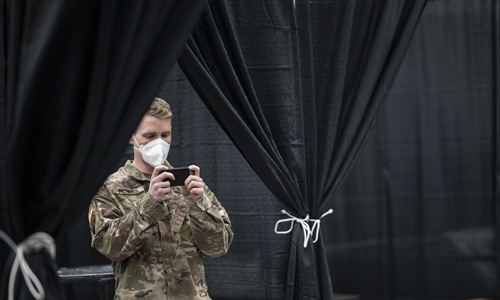US military threatened by COVID-19 still insists on showing off might
By Hu Bo Source:Global Times Published: 2020/4/13 19:03:40

A soldier wearing a mask takes a photo at a temporary hospital located at the USTA Billie Jean King National Tennis Center during the outbreak of the novel coronavirus (which causes COVID-19), in the Queens borough on Sunday in New York City. Photo: AFP
The still raging coronavirus pandemic has had a tremendous impact on global politics, the economy and societies, and is posing a severe challenge to the military deployment and combat readiness of many countries. The US military is deployed in more than 150 countries around the world with roughly 175,000 active-duty personnel serving outside of the US, which makes it the most vulnerable to the pandemic. As of Friday, there has been more than 3,300 confirmed COVID-19 cases in the US defense system, of which 60 percent are active-duty military personnel.The US Pacific Fleet and US Indo-Pacific Command Headquarters are most vulnerable to the coronavirus. Almost all US Pacific bases report personnel infected with COVID-19, including Pearl Harbor, San Diego, Yokosuka, Kitsap-Bangor, and Kadena. Confirmed cases have been detected on four aircraft carriers - USS Ronald Reagan, USS Theodore Roosevelt, USS Nimitz and USS Carl Vinson - with more than 400 confirmed cases on the Roosevelt.
As the most powerful military force in the world, with the highest level of combat readiness, the US military's failure to contain the virus has been disappointing. There are number of reasons for this, such as the large number of personnel deployed overseas, poor military-political relations, and the absence preparedness. The crux of the problem, however, lies in the fact that the US military is facing a dilemma that is impossible to deal with. The US military and intelligence system realized early on the severity of the epidemic and took control measures, while repeatedly warning the White House and the Pentagon.
In the context of strategic competition among major powers, it has always been politically correct for Washington to increase competition with China and other countries. Since the outbreak of the pandemic, the US military has been faced with the dilemma of simultaneously strengthening prevention and control of the epidemic while being ordered to intensify military competition with China and Russia. In February and March, as the pandemic grew increasingly grim in Asia, the frequency of US military activities in the South China Sea and other waters remained considerable. The main battle groups of the US Pacific Fleet, including the USS Roosevelt Aircraft Carrier Strike Group, the USS America Amphibious Ready Group, and the USS Blue Ridge, have all made cruises, and conducted exercises in and around the South China Sea.
By the end of March, as the pandemic became more severe, senior officials of the US Department of Defense and US Indo-Pacific Command Headquarters undertook anti-pandemic measures but still maintained combat readiness. Although coping with the pandemic is now the primary task of the US military, it still maintains a significant presence in the West Pacific Ocean, unwilling to show weakness to the outside world.
The US military is now refusing to release more details on confirmed COVID-19 cases within its ranks. This is to avoid revealing a weakness while continuing its patrols in sensitive areas. US naval activities in the East China Sea and the South China Sea have significantly decline, but aerial reconnaissance missions continue unabated. Since the USS Empress of China visited China in 1784, there have been military conflicts between China and the US, but China has never been the aggressor nor threatening military conflict against the US. In recent years, China has made remarkable achievements in the modernization of its national defense and has greatly enhanced its military strength, but it has never changed its defensive strategy of protecting its rights and interests.
With increased national strength, China will naturally expand the range and intensity of its activity, and will safeguard its inherent maritime interests more resolutely and pursue a more open and inclusive international maritime security order. While it's understandable that the US military will continue to demonstrate a certain degree of vigilance, the US remains close to paranoid about the "China threat" theory. Even at this critical moment, when the need for global cooperation to fight the epidemic is at its height, the US still cannot let go of its prejudices.
With its preoccupation of the "China threat" theory, the US is failing to recognize that the coronavirus pandemic is its main adversary, not China.
The author is director of the Peking University Center for Maritime Strategy Studies. opinion@globaltimes.com.cn
Posted in: VIEWPOINT